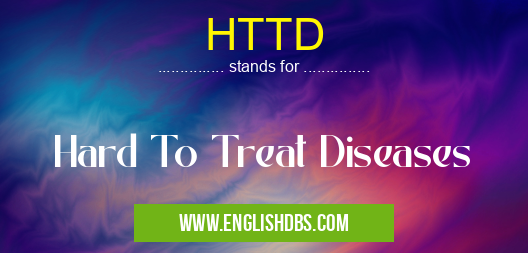What does HTTD mean in DISEASES
HTTD (Hard to Treat Diseases) refers to diseases that exhibit exceptional resistance to standard treatment approaches, often resulting in significant morbidity and mortality. These diseases pose a formidable challenge to healthcare professionals, researchers, and patients alike.

HTTD meaning in Diseases in Medical
HTTD mostly used in an acronym Diseases in Category Medical that means Hard To Treat Diseases
Shorthand: HTTD,
Full Form: Hard To Treat Diseases
For more information of "Hard To Treat Diseases", see the section below.
Causes of HTTDs
- Multifactorial Pathogenesis: HTTDs are characterized by complex and multifaceted mechanisms, involving genetic, environmental, and immune system interactions.
- Antimicrobial Resistance: The rise of antimicrobial resistance has led to the emergence of bacteria and other pathogens that are difficult to treat with conventional antibiotics.
- Adaptive Evolution: Pathogens may undergo evolutionary changes to circumvent the effects of existing therapies, rendering them ineffective.
Challenges in Treating HTTDs
- Limited Treatment Options: HTTDs often have a limited range of effective treatment options, which may be associated with adverse side effects and reduced efficacy over time.
- Lack of Diagnostic Tools: Early and accurate diagnosis of HTTDs can be challenging, leading to delayed or inappropriate treatment.
- High Cost of Treatment: The development and use of novel therapies for HTTDs can be expensive, creating financial barriers for patients.
Impact on Patients and Society
- Morbidity and Mortality: HTTDs contribute significantly to morbidity and premature mortality worldwide.
- Economic Burden: The healthcare costs associated with HTTDs are substantial, placing a strain on healthcare systems and individuals.
- Stigma and Social Isolation: Patients with HTTDs may face stigma and social isolation due to the chronic and debilitating nature of their condition.
Research and Development
- Innovative Therapies: Ongoing research is focused on developing innovative therapies, such as targeted therapies, immunotherapy, and gene editing, to address the challenges of HTTDs.
- Precision Medicine: Precision medicine approaches aim to tailor treatments based on individual patient characteristics, including genetic profiles and immune markers.
- Surveillance and Control: Surveillance and control measures are essential to monitor the spread of HTTDs and identify potential outbreaks.
Essential Questions and Answers on Hard To Treat Diseases in "MEDICAL»DISEASES"
What are Hard To Treat Diseases (HTTDs)?
HTTDs are diseases that pose significant challenges in diagnosis, treatment, and management due to their complex nature, limited treatment options, and often severe or life-threatening symptoms.
What are some examples of HTTDs?
HTTDs include rare diseases, chronic conditions, and infectious diseases such as cancer, Alzheimer's disease, HIV/AIDS, cystic fibrosis, and antibiotic-resistant bacterial infections.
Why are HTTDs difficult to treat?
HTTDs are often difficult to treat because they may have multiple causes, involve complex biological pathways, lack effective therapies, or develop resistance to existing treatments.
What are the challenges in developing treatments for HTTDs?
Developing treatments for HTTDs requires extensive research, clinical trials, and regulatory approvals. Challenges include understanding disease mechanisms, identifying potential drug targets, and ensuring safety and efficacy.
What are the ongoing efforts to address HTTDs?
Ongoing efforts include increased funding for research, collaboration between researchers and clinicians, development of personalized and precision medicine approaches, and advocating for improved healthcare policies and access to care.
What can patients with HTTDs do to manage their condition?
Patients with HTTDs should work closely with their healthcare team to develop a personalized treatment plan. This may involve a combination of therapies, lifestyle modifications, and support services. Regular follow-up and adherence to treatment protocols are crucial.
What resources are available for patients and families affected by HTTDs?
Numerous resources are available to provide support and information to patients and families affected by HTTDs, including patient advocacy groups, support networks, and online communities. These resources can connect individuals with others facing similar challenges and provide access to valuable information.
Final Words: HTTDs are a major public health concern, posing significant challenges to healthcare systems and patients. Understanding the causes, challenges, and impact of HTTDs is crucial for developing effective strategies for prevention, diagnosis, and treatment. Ongoing research and collaboration are essential to address the unmet medical needs associated with HTTDs and improve patient outcomes.
